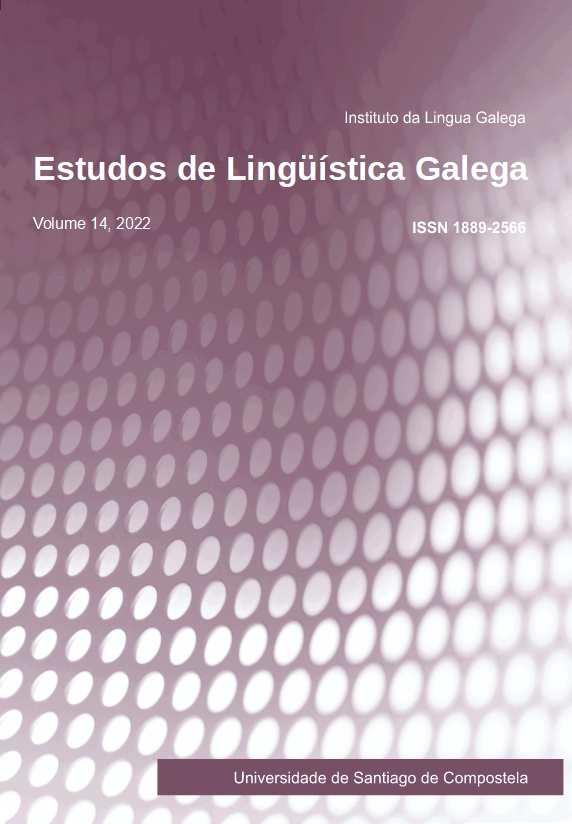The semantic field of colour through the eyes of three generations
Main Article Content
Abstract
It is widely held that named colour categories in the world’s languages are organized around universal focal colours, or prototypes. This paper examines this semantic field in Galician oral use. We chose five Galician-speaking families in the villages of Xesteira and Almofrei that had members pertaining to three generations. Twenty two interviews were carried out and provide the lexical material discussed in this study, which thus attempts to present the colour categories in a Galician micro-community, track linguistic changes and document their semantic consequences. As the younger generations move towards greater lexical homogeneity, they show a preference for terms learned at school over the words they heard at their grandmother’s knee, and establish more clearcut categories along the colour continuum. Spanish language contact has contaminated the colour lexicon with Castilian forms or new meanings for inherited terms. We document the route followed by words through three generations, the disuse into which some forms have fallen and the recovery of others as a consequence of bringing Galician into the school curriculum.
Keywords:
Article Details
References
Berlin, Brent / Paul Kay (1969): Basic Color Terms: Their Universality and Evolution. Berkeley: University of California Press.
DXL= Carballeira Anllo, Xosé María (coord.) (2007): Dicionario Xerais da Lingua: Vigo: Xerais.
Corominas, Joan/ José A. Pascual, (1983-1985): Diccionario Crítico Etimológico Castellano e Hispánico, 5 vols. Madrid: Gredos.
Croft, William (2003): Typology and Universals. Cambridge: Cambridge University Press.
Eco, Umberto (1978): La estructura ausente. Barcelona: Lumen.
Espejo, María del Mar (1990): Los nombres de los colores en español. Granada: Universidad de Granada.
Espejo, María del Mar (1996): Los nombres de color en la naturaleza. Granada: Universidad de Granada.
Hilferty, Joseph (1993): ‘Semántica lingüística y cognición’, Verba 20, 29-44.
Labov, William (2001): Principles of Linguistic Change, vol.II. Oxford: Blackwell.
Luque Durán, Juan de Dios (2001): Aspectos universales y particulares del léxico de las lenguas del mundo. Granada: Método (Estudios de Lingüística del Español, 21).
Maclaury, Robert (1997): Color and cognition in Mesoamerica: Constructing categories as vantages. Austin: University of Texas Press.
Moure, Teresa (2001): Universales del lenguaje y linguo-diversidad. Barcelona: Gredos.
Rodríguez Río, Xusto A. (1998): “O tratamento dos préstamos na norma léxica do galego”, Verba 25, 293-322.
Rodríguez Río, Xusto A. (2003): “Os préstamos na producción lexicográfica, terminográfica e enciclopédica galega actual” en María Álvarez de la Granja / Ernesto Xosé González Seoane (eds.), A estandarización do léxico. Santiago de Compostela: Consello da Cultura Galega / Instituto da Lingua Galega, 419-446.
Rosch, Eleanor (1972): “Universals in color naming and memory”, Journal of Experimental Psychology 93, 10-20.
Rosch, Eleanor (1978): “Principles of categorization”, en Eleanor Rosch / Barbara B. Lloyd (eds.), Cognition and categorization. Hillsdale, NJ: Erlbaum, 27-48.
Santamarina, Antón (ed.) (2003): Diccionario de diccionarios. A Coruña: Fundación Pedro Barrié de la Maza.
Soares da Silva, Augusto (1997): A semântica de deixar: uma contribuição para a abordagem cognitiva em semântica lexical. Braga: Universidade Católica Portugesa.
Soares da Silva, Augusto (2006): O mundo dos sentidos em português. Polissemia, Semântica e Cognição. Coimbra: Almedina.
Taylor, John R. (1989): Linguistic categorization: prototypes in linguistic theory. Oxford: Clarendon Press.
Villanueva Gesteira, María Dolores (2006): Lingua en sociedade. A aldea da Xesteira. Pontevedra: Deputación de Pontevedra.


